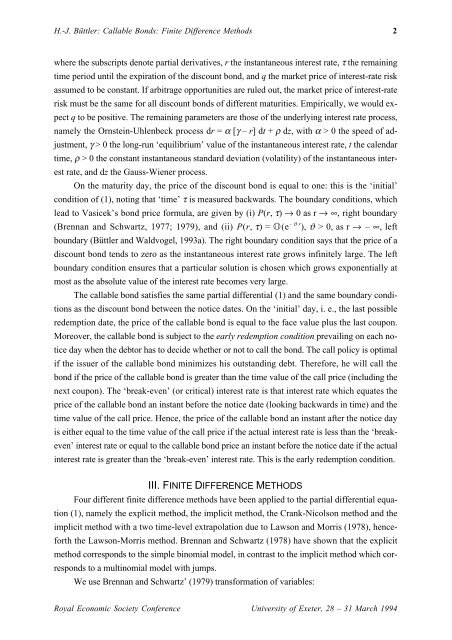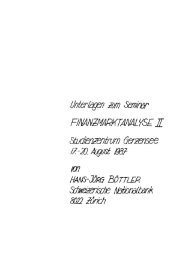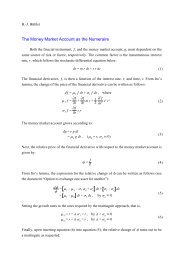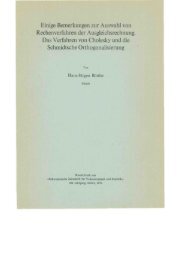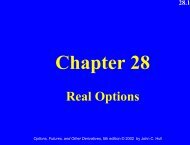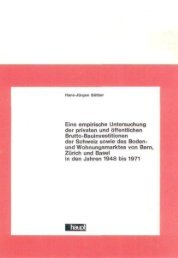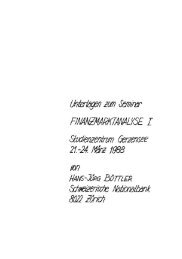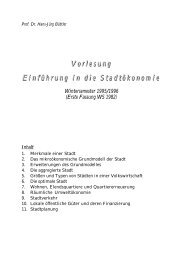Callable Bond/EJ/e
Callable Bond/EJ/e
Callable Bond/EJ/e
You also want an ePaper? Increase the reach of your titles
YUMPU automatically turns print PDFs into web optimized ePapers that Google loves.
H.-J. Büttler: <strong>Callable</strong> <strong>Bond</strong>s: Finite Difference Methods 2<br />
where the subscripts denote partial derivatives, r the instantaneous interest rate, τ the remaining<br />
time period until the expiration of the discount bond, and q the market price of interest-rate risk<br />
assumed to be constant. If arbitrage opportunities are ruled out, the market price of interest-rate<br />
risk must be the same for all discount bonds of different maturities. Empirically, we would expect<br />
q to be positive. The remaining parameters are those of the underlying interest rate process,<br />
namely the Ornstein-Uhlenbeck process dr = α [γ – r] dt + ρ dz, with α > 0 the speed of adjustment,<br />
γ > 0 the long-run ‘equilibrium’ value of the instantaneous interest rate, t the calendar<br />
time, ρ > 0 the constant instantaneous standard deviation (volatility) of the instantaneous interest<br />
rate, and dz the Gauss-Wiener process.<br />
On the maturity day, the price of the discount bond is equal to one: this is the ‘initial’<br />
condition of (1), noting that ‘time’ τ is measured backwards. The boundary conditions, which<br />
lead to Vasicek’s bond price formula, are given by (i) P(r, τ) → 0 as r → ∞, right boundary<br />
(Brennan and Schwartz, 1977; 1979), and (ii) P(r, τ) = (e – ϑ r ), ϑ > 0, as r → – ∞, left<br />
boundary (Büttler and Waldvogel, 1993a). The right boundary condition says that the price of a<br />
discount bond tends to zero as the instantaneous interest rate grows infinitely large. The left<br />
boundary condition ensures that a particular solution is chosen which grows exponentially at<br />
most as the absolute value of the interest rate becomes very large.<br />
The callable bond satisfies the same partial differential (1) and the same boundary conditions<br />
as the discount bond between the notice dates. On the ‘initial’ day, i. e., the last possible<br />
redemption date, the price of the callable bond is equal to the face value plus the last coupon.<br />
Moreover, the callable bond is subject to the early redemption condition prevailing on each notice<br />
day when the debtor has to decide whether or not to call the bond. The call policy is optimal<br />
if the issuer of the callable bond minimizes his outstanding debt. Therefore, he will call the<br />
bond if the price of the callable bond is greater than the time value of the call price (including the<br />
next coupon). The ‘break-even’ (or critical) interest rate is that interest rate which equates the<br />
price of the callable bond an instant before the notice date (looking backwards in time) and the<br />
time value of the call price. Hence, the price of the callable bond an instant after the notice day<br />
is either equal to the time value of the call price if the actual interest rate is less than the ‘breakeven’<br />
interest rate or equal to the callable bond price an instant before the notice date if the actual<br />
interest rate is greater than the ‘break-even’ interest rate. This is the early redemption condition.<br />
III. FINITE DIFFERENCE METHODS<br />
Four different finite difference methods have been applied to the partial differential equation<br />
(1), namely the explicit method, the implicit method, the Crank-Nicolson method and the<br />
implicit method with a two time-level extrapolation due to Lawson and Morris (1978), henceforth<br />
the Lawson-Morris method. Brennan and Schwartz (1978) have shown that the explicit<br />
method corresponds to the simple binomial model, in contrast to the implicit method which corresponds<br />
to a multinomial model with jumps.<br />
We use Brennan and Schwartz’ (1979) transformation of variables:<br />
Royal Economic Society Conference University of Exeter, 28 – 31 March 1994


